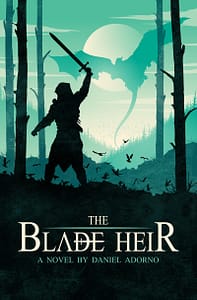I recently came across an article on The Guardian’s US money blog entitled, “You can try to be the next Hemingway — for $6,000” by Suzanne McGee and I was curious to read what Ms. McGee had to say. I was shocked and somewhat irked to read her cost breakdown for self-publishing a book. Not only was the $6,000 price tag ridiculously high, but the article contains lots of misinformation about self-publishing itself. In order to prevent would-be authors from abandoning self-publishing as an option based on this article, I wanted to provide my experience and cost breakdown for my self-published novel and counter some of McGee’s claims.
I’ll break down this post in sections mirroring McGee’s article with her own words on the cost of each item then I’ll give my perspective. Ready? Let’s go.
ISBN $125
McGee states that,
“Some costs are simply table stakes; you’ll need an ISBN, for instance, the number that identifies the book to any retailer or distributor. They cost $125 each…”
The cost here is accurate, but you really don’t need an ISBN. Ebooks don’t require ISBNs to be published on Amazon, B&N.com, or Smashwords–the most popular markets for ebooks. Smashwords even provides you with a free ISBN that you can use for identifying your book. On the print side of things, you can also get a free ISBN if you publish your paperback through Createspace. A free Createspace-assigned ISBN will display them as your publisher, but if you want to name a different publisher for your book you can pay $10 instead (this is what I did for my novel). If you desire complete control over your ISBN, meaning you can use the number with any distributor of your choosing, then you’ll need to pay $125 like McGee states. However, most of the revenue stream for self-published titles is in the ebook market, which I’ve experienced myself the last few weeks my book has been available on Amazon. I’ve yet to sell more than two paperbacks on Amazon, but my ebook sales have placed me on the top five for new releases in my genre. So your mileage may vary with regard to ISBNs and their supposed necessity.
Editing: $4,000
McGee states that,
“The crucial expense – and the one you shouldn’t even think of ducking if you want to have your book read and appreciated – is editing. Not just proofreading, or even copy editing, but content editing, starting early in the process.”
This is the most outlandish expense McGee lists and I really want to know where she arrived at this number. Editing is expensive if you decide to get a full content edit, but why would you want to? Content edits are done by large publishers to make novels more favorable to market trends and conditions, which are constantly changing. Do you as an author really want to significantly change your story and your voice for the sake of appealing to the masses? I don’t and most authors who are proud of their writing don’t either.
Aside from that, the substantial edits McGee recommends can cost you half the price if you do some research, but I honestly think proofreading and copyediting is all that’s necessary. The prices I saw for copyediting services provided by professional and experienced editors ranged from $800-$1,500–almost 1/4th of the cost presented in McGee’s article. If you’re really trying to cut your costs on editing then I recommend my editor, Holly Bohl, whose prices are significantly lower than the average editing costs. I paid $200 for my 80,000+ word novel and Holly provided a professional edit in less than a month. You can’t beat that!
Cover art: $750
McGee states,
“Just because you decide to stick to an e-book doesn’t mean that you get to skimp when it comes to cover art. But the hourly costs are much lower, so the bill can be much smaller – $750 or so for a well-designed cover –”
I would argue that $750 for a cover is way too much, especially if you’re self-publishing for the first time. While you can easily spend that much for some quality design work on your book cover it is not necessary nor wise. For my book cover, I reached out to a friend who is a freelance artist and runs the website, Sevenlives Designs.

Based on the feedback I’ve received, I think Sevenlives Designs did an excellent job on my fantasy novel’s cover. The best part is that I didn’t pay anywhere near $750 for it. If you look around online, you can easily find book cover services or artists who will design a cover in the $200-400 range, depending on what you’re looking for. You can also do the cover yourself if you’re artistically-inclined, but I encourage you to read my previous post if you decide to go that route.
Reviews: $825
McGee writes:
“There are two ways that a self-published author can get their magnum opus into a reviewer’s hands. If you’ve already decided that you’re going to make a physical book available, using a service like CreateSpace or Lulu, you can simply order author’s copies…and mail them to the bloggers who have promised to review the novel.
[Another] option is making your book available to interested reviewers and bloggers on NetGalley, which…will now set you back about $400.”
First of all, most bloggers that review books are fine with an electronic file submission–it’s quick and convenient for them. I’ve never read anywhere that blogger’s prefer physical copies. Many book review blogs have pages set up on their site specifically for uploading ebook files for review, so this is a non-issue as far as cost goes.
Second, Netgalley can be kind of a toss up with regards to helping you gain reviews for your book. Reviewers on Netgalley consist of bloggers, educators, librarians, journalists, and booksellers–all the kind of people that can get your book noticed with glowing reviews. But many indie authors have experienced two common problems with Netgalley: overly harsh reviews and little to no reviews of their books. On the other hand, there are also some indie authors who’ve had success with the service and recommend it for gaining exposure. Personally, I think it’s too much of an expense and hassle than seeking reviews through beta-readers, social media, or bloggers. Plus the propensity for negative reviews that don’t take into account the genre, plot, or characters of your book seems high. It’s likely that Netgalley reviewers suffer from the “free book effect,” wherein they download books without reading synopses because they’re all free. Great setup for them, but not so much for a fledgling author who’s now got 1 star on Amazon because the reviewer posted that “fantasy suckz.”
Review copies: reserve $300
McGee writes:
“Mailing out hard copies of books – giveaways or review copies – might be a good way to drum up interest in your new title, but it’s not just about the cost of the book…”
I wholeheartedly agree with McGee that mailing out physical copies of books through giveaways or contests is effective in netting new readers and stirring up interest in your book. But the cost for review copies is off the mark. I ordered 17 review copies of my book through Createspace and paid $107.89 which includes shipping. If I doubled that order to 34 books the total would be $215.78, less than the cost McGee says to reserve. Of course, the price of a physical copy will vary depending on trim size, page count, color, etc. so McGee might be justified in using the $300 figure for larger books, but I wanted to highlight my own experience in this area.
Total: $6,000
McGee concludes:
“So is it worth it? For all the hassle, the expense – and in spite of the fact that the market is getting more crowded, making it harder than ever for any single title to stand out from the crowd?”
I think it’s definitely worth it to self-publish your own book and retain creative control of your story. Despite the amount of hard work involved, it’s been incredibly rewarding to see my book in print and see it actually selling on Amazon. The best part is that it didn’t cost me $6,000 to do it and it doesn’t have to cost that much for you either. I would estimate that I spent less than $1,000 to self-publish my novel and more than half of that was paid through crowdfunding on Pubslush. (I’ll have a detailed blog post soon on my crowdfunding experience and why I think it’s beneficial for indie authors).
The best advice I can give to anyone looking to self-publish is to do your research. Look at everything on this list and make a budget for each category. You might decide to spend more on editing or a book cover than I did. Or maybe you don’t want physical copies of your book and want to stick to the ebook market on Amazon. Whatever your inclinations may be just remember to budget and find deals that don’t compromise on quality. There’s no reason you can’t create a quality self-published book for $2,000 or less. And if you’re spending $6,000, you’re doing something wrong.



Very informative post. Thank you, Daniel!
Thanks Lena, I’m glad you found it useful!
Hi, Daniel!
Hope you’re well!
I liked your post. I must comment on one thing, though. I think spending $6,000 or above isn’t wrong. So long as you truly believe that it’s worth it…then I see no wrong with that. Come on, you would only publish once (at least for a single book). So, why not expend if it’s for the best? I know we have different point of views in terms of some things like budget. But I really think that it would be better if you would truly invest into your craft at once. You’ll never know what will happen just by tomorrow so might as well give your all. 🙂
But I must agree with you that every author should do much of “research”. We must also be careful of the things we’ll discover on the internet. We know that internet is simply the bumping place for anything if not everything.
Nonetheless, THAAAAAANK YOU SOOOOOOO MUCH!
P.S. I’ve tested publishing my books in different self-publishers, 1 in Tate publishing, 1 in Xlibris and 1 in AuthorHouse. In all fair view. Outputs were quite amazing. They are in competition with each other so I tested. I was contented with the results. . I opted not to publish via lulu because they have limited online resellers.:D
Hi Macy,
Thanks for your comments on the article. I don’t necessarily have a problem with an author spending $6,000 or more on self-publishing their book if that’s what they planned for from the get-go. My issue is with the misinformation that you need to spend that much money to self-publish. If I would have been told that was how much I needed to self-publish my first book, I might have abandoned it altogether. So I don’t want indie authors who are on the fence to forgo self-publishing because of sticker shock that isn’t warranted. But you’re right that we should be willing to invest into our craft and give it our all. I think it’s imperative not to sacrifice quality for the sake of saving a few bucks and that’s the research part is so crucial. Thanks again for posting!